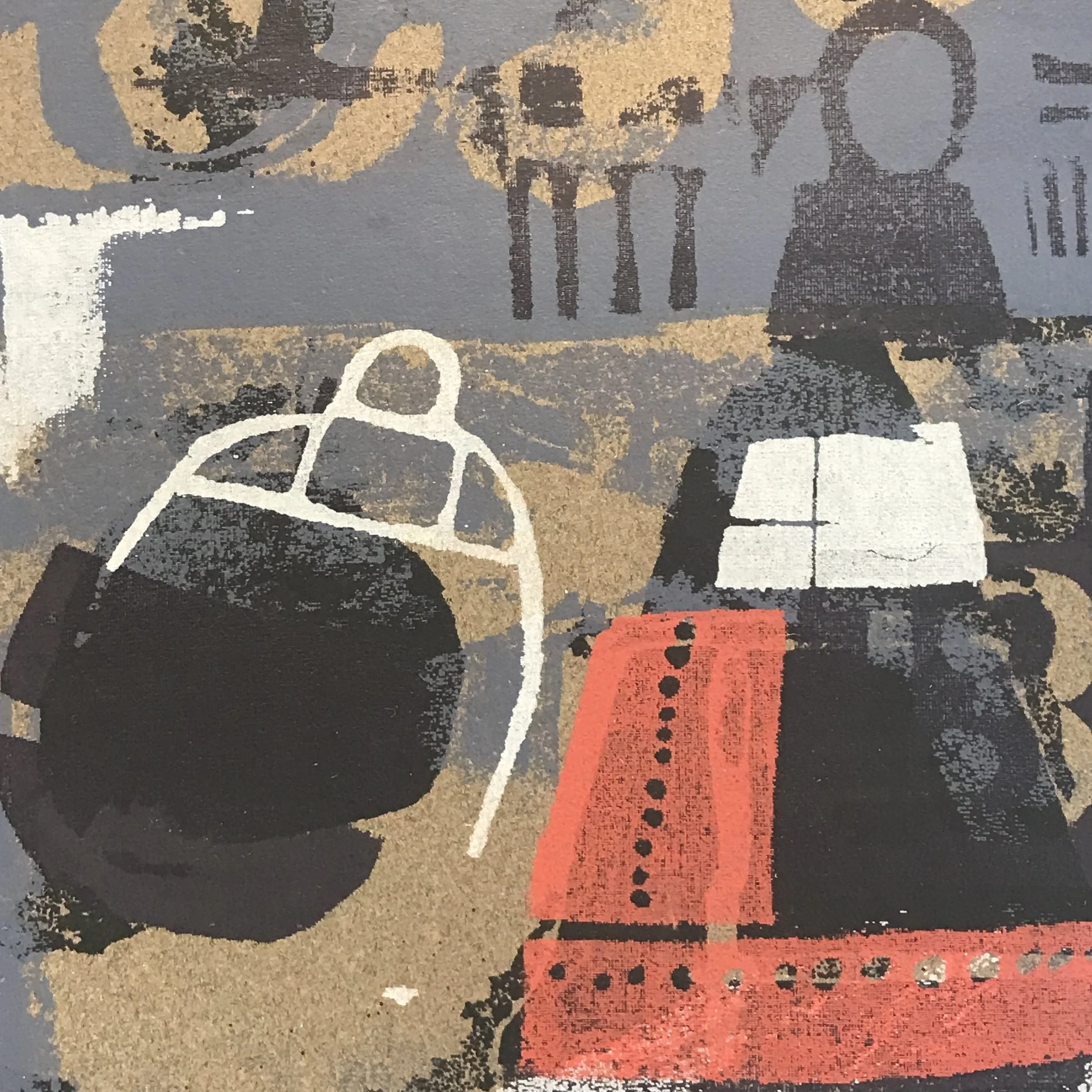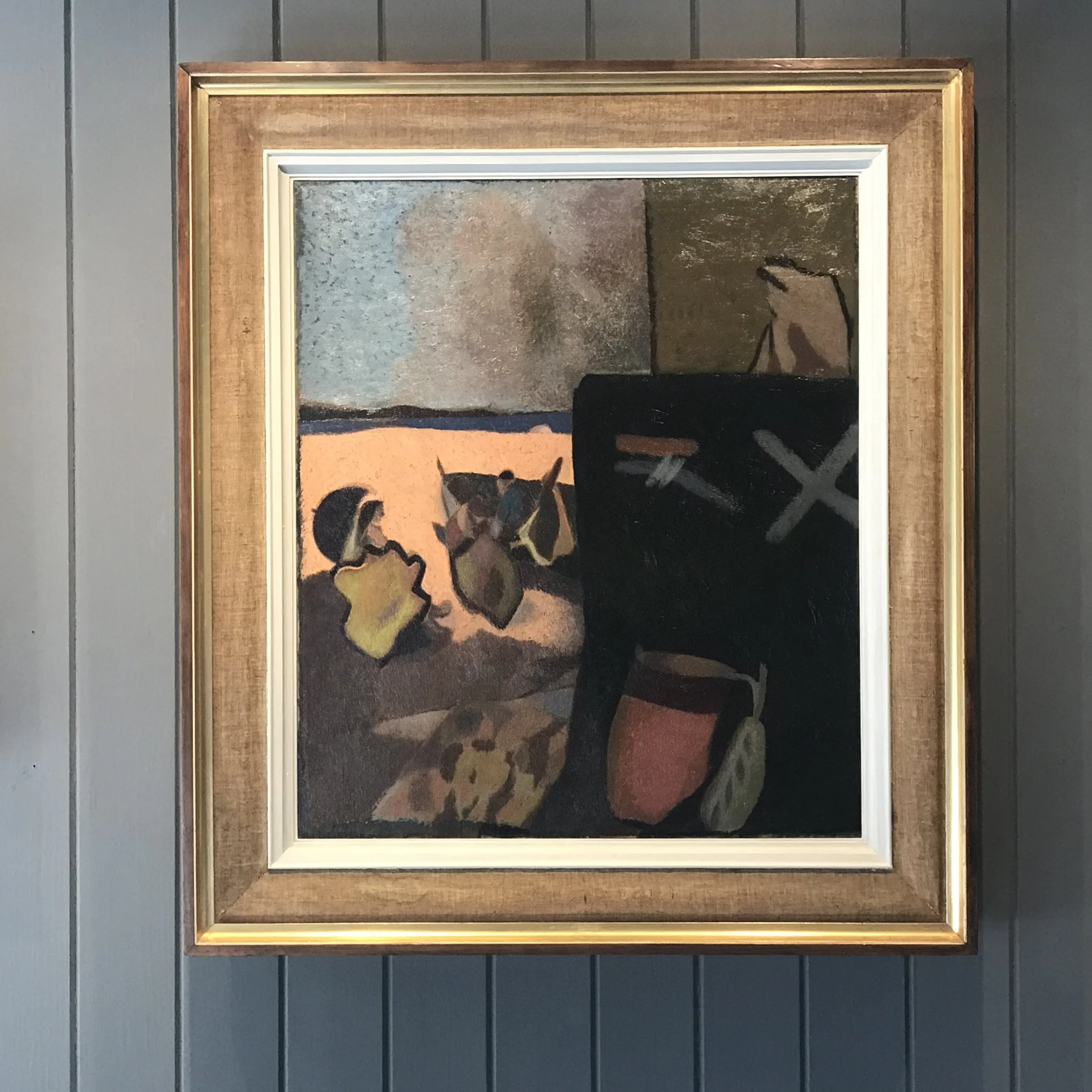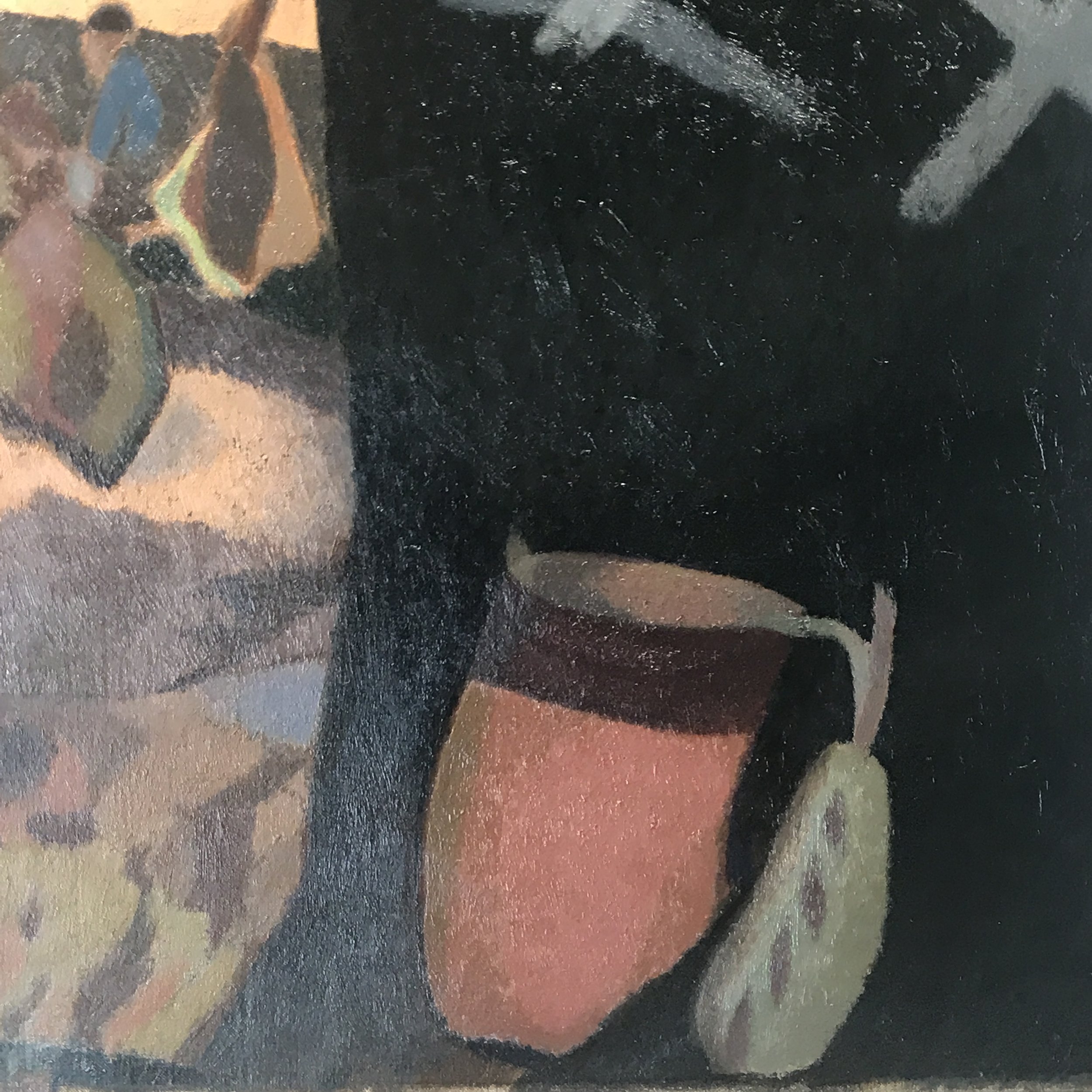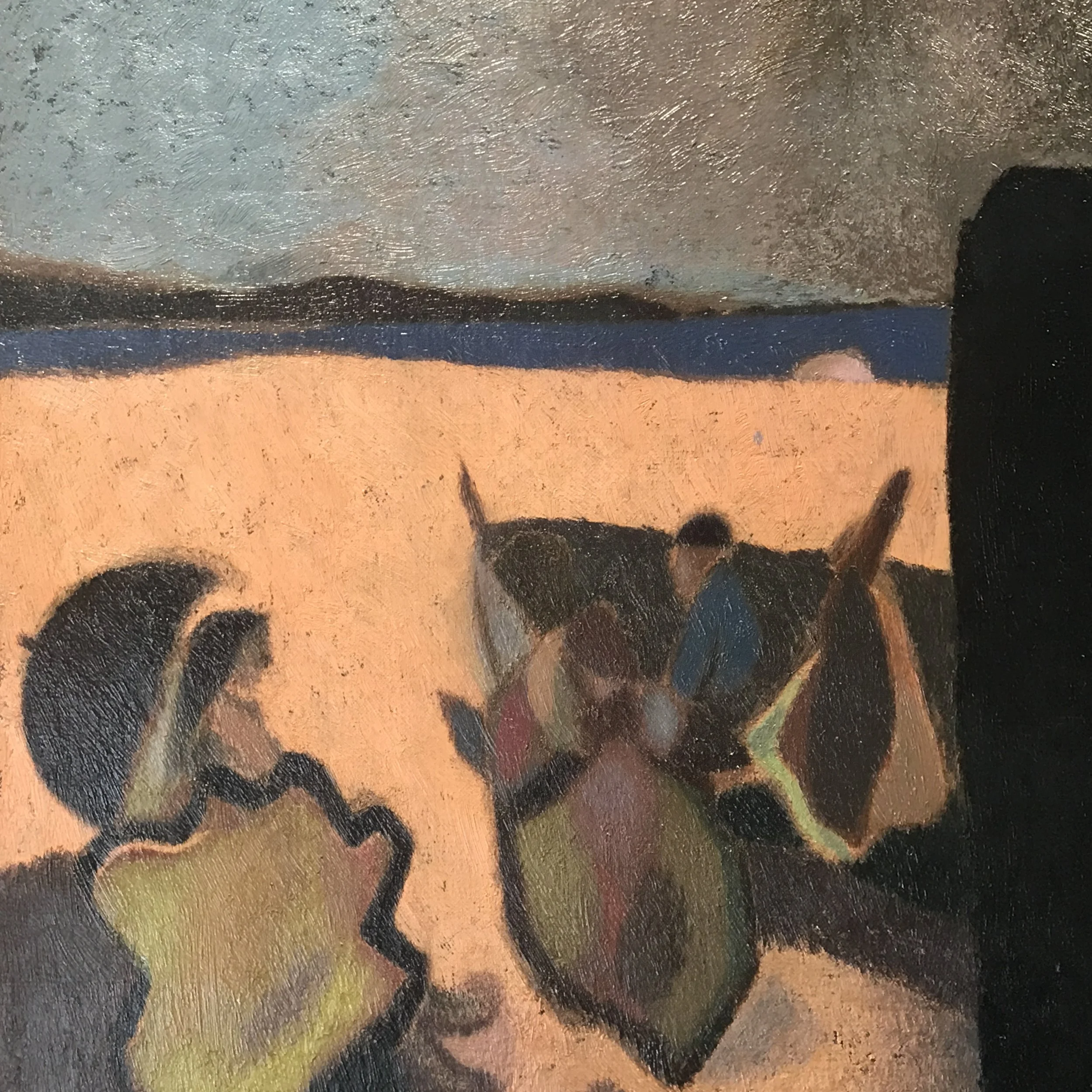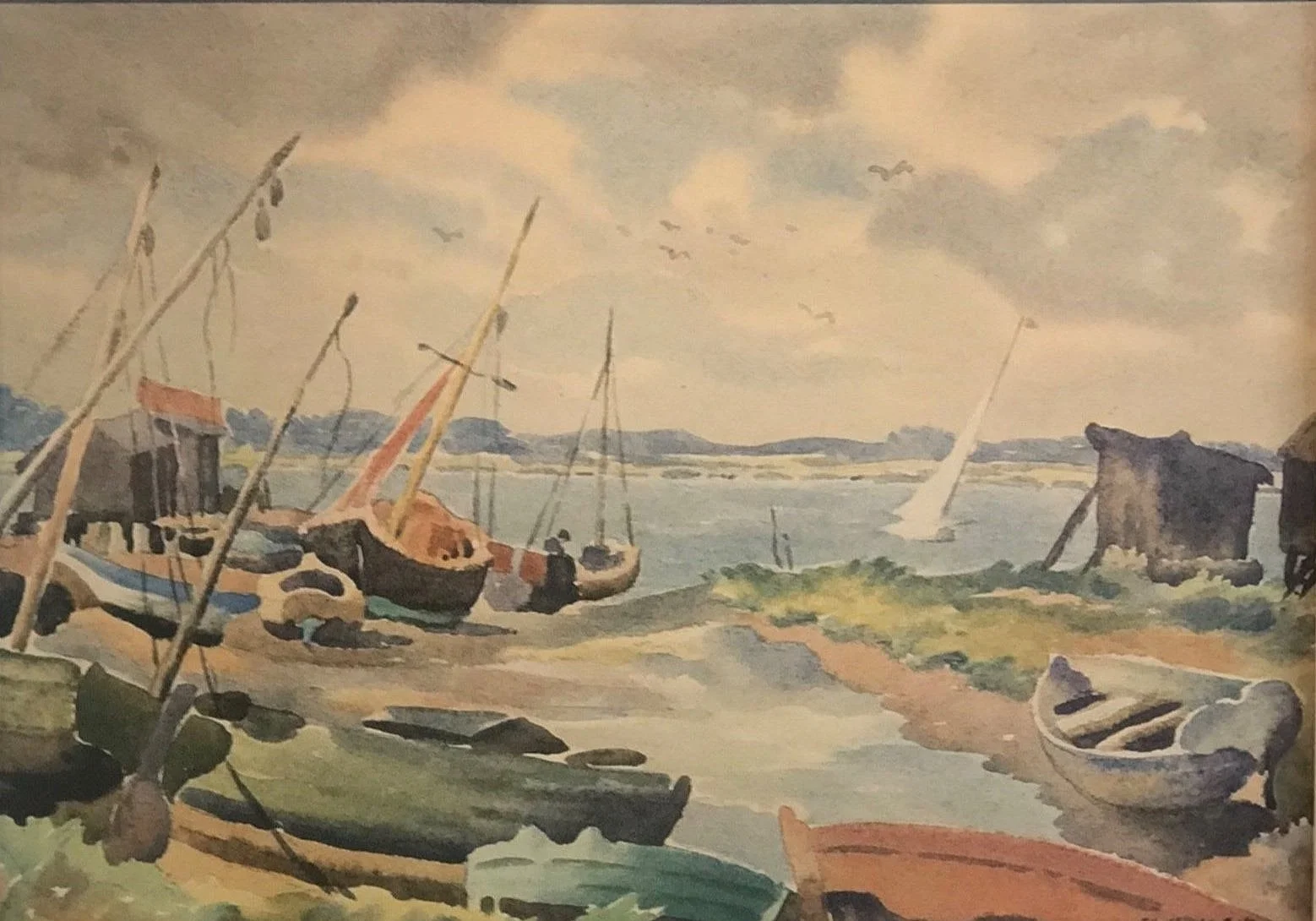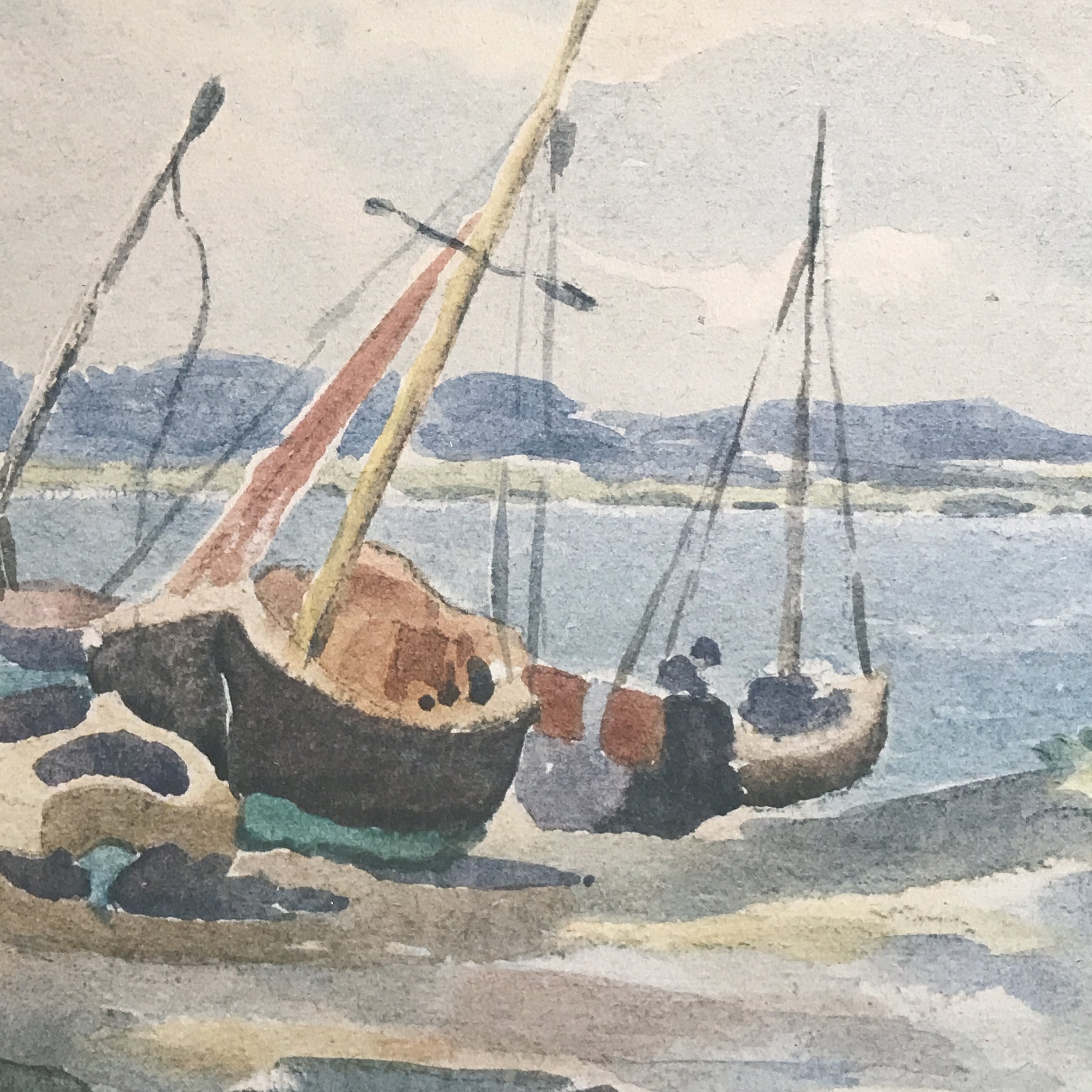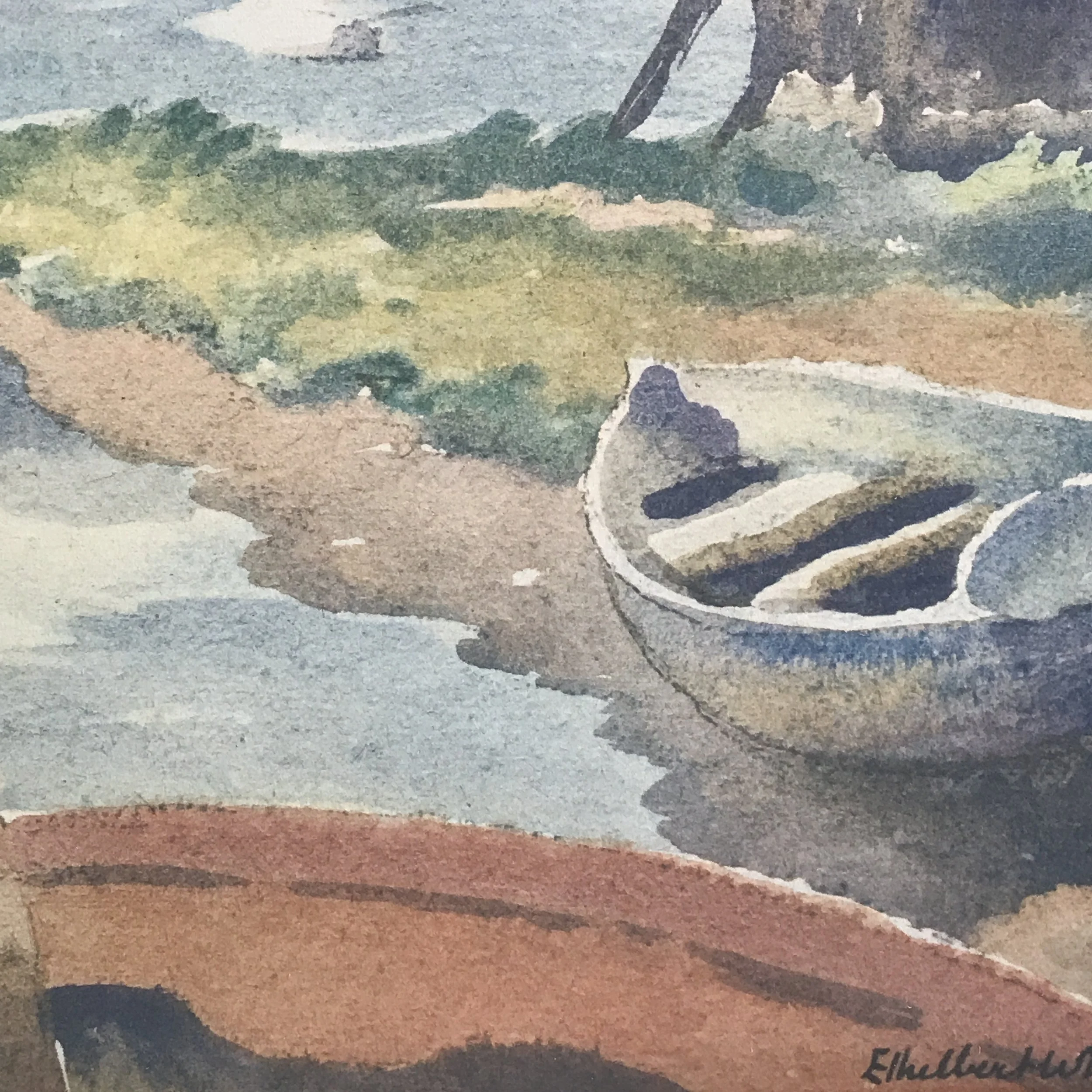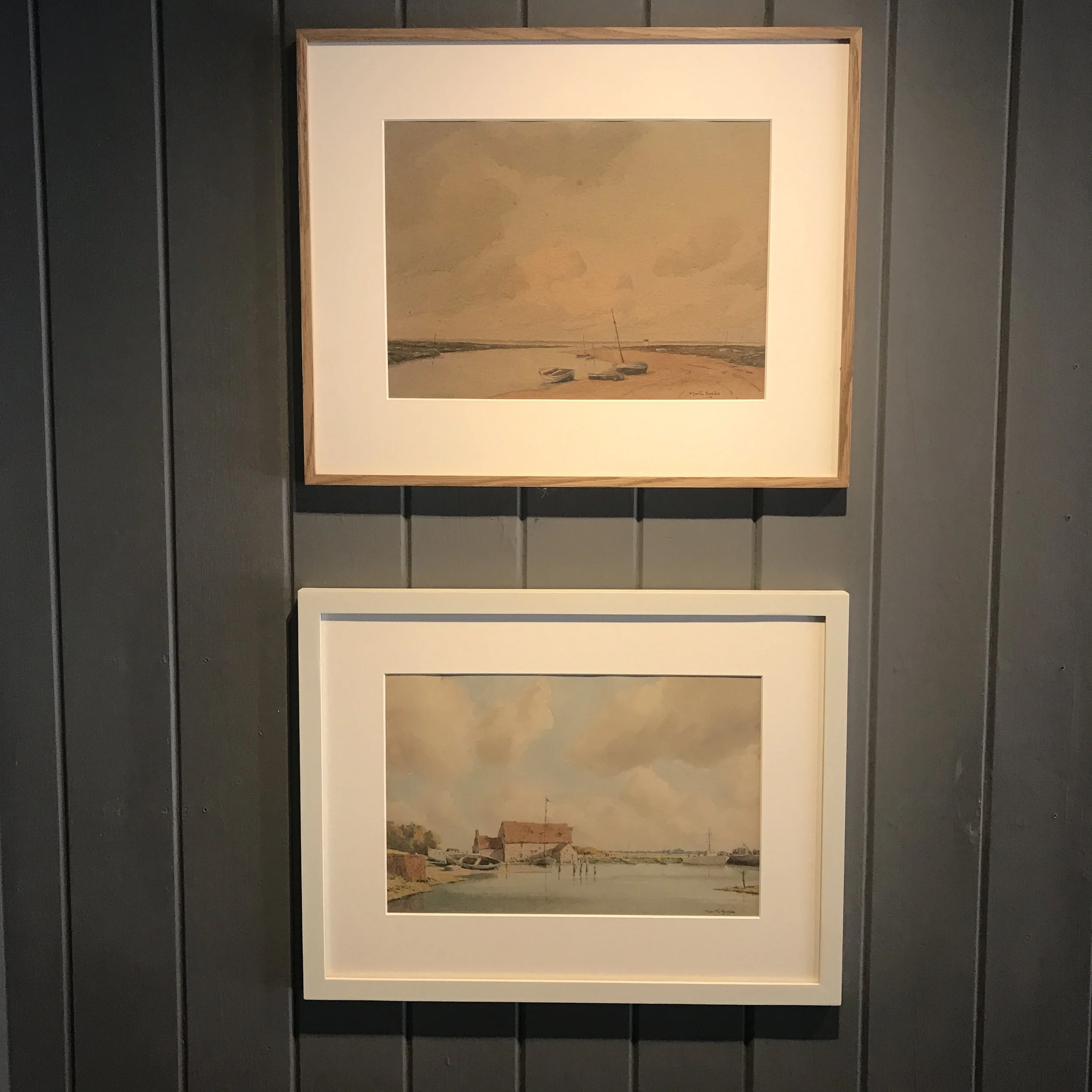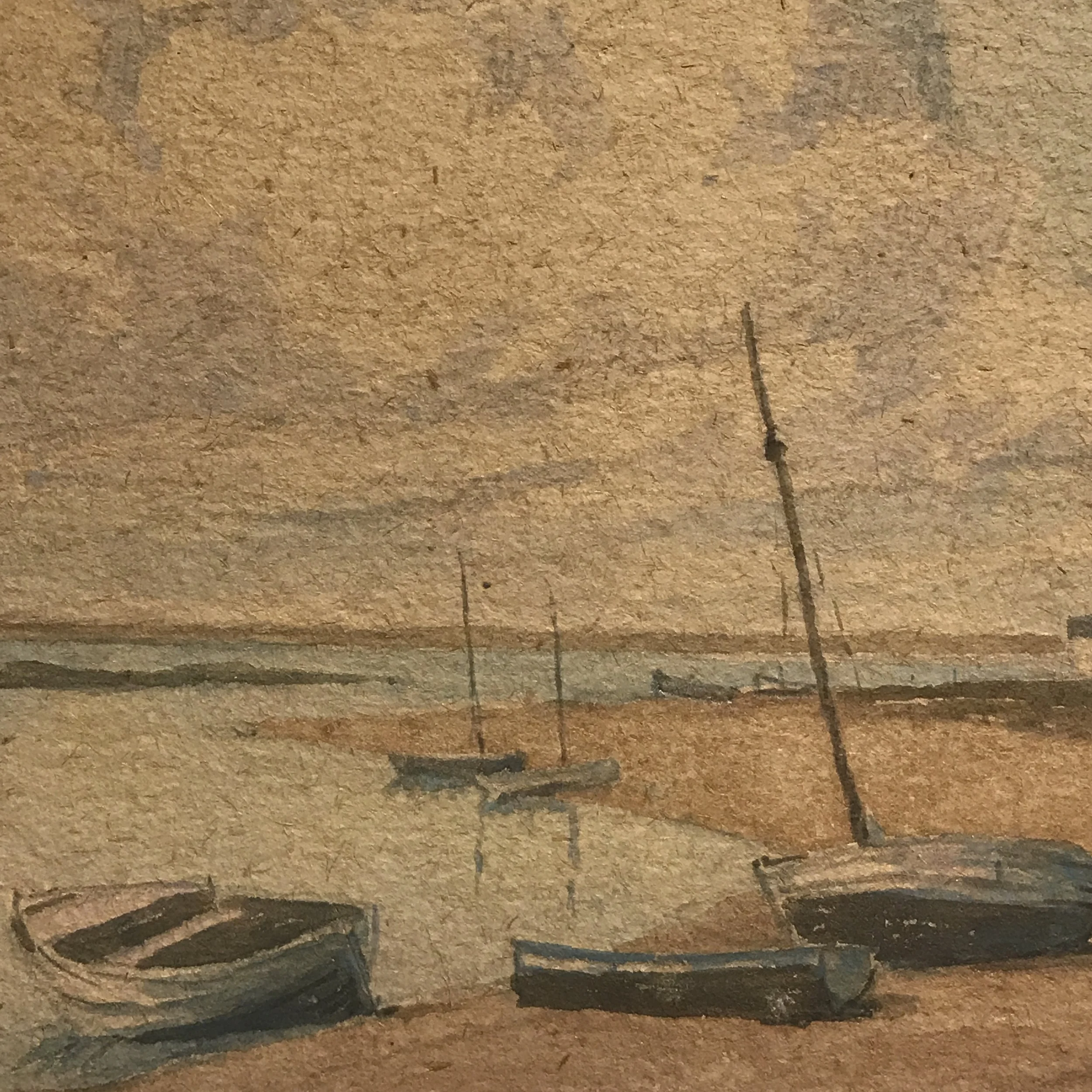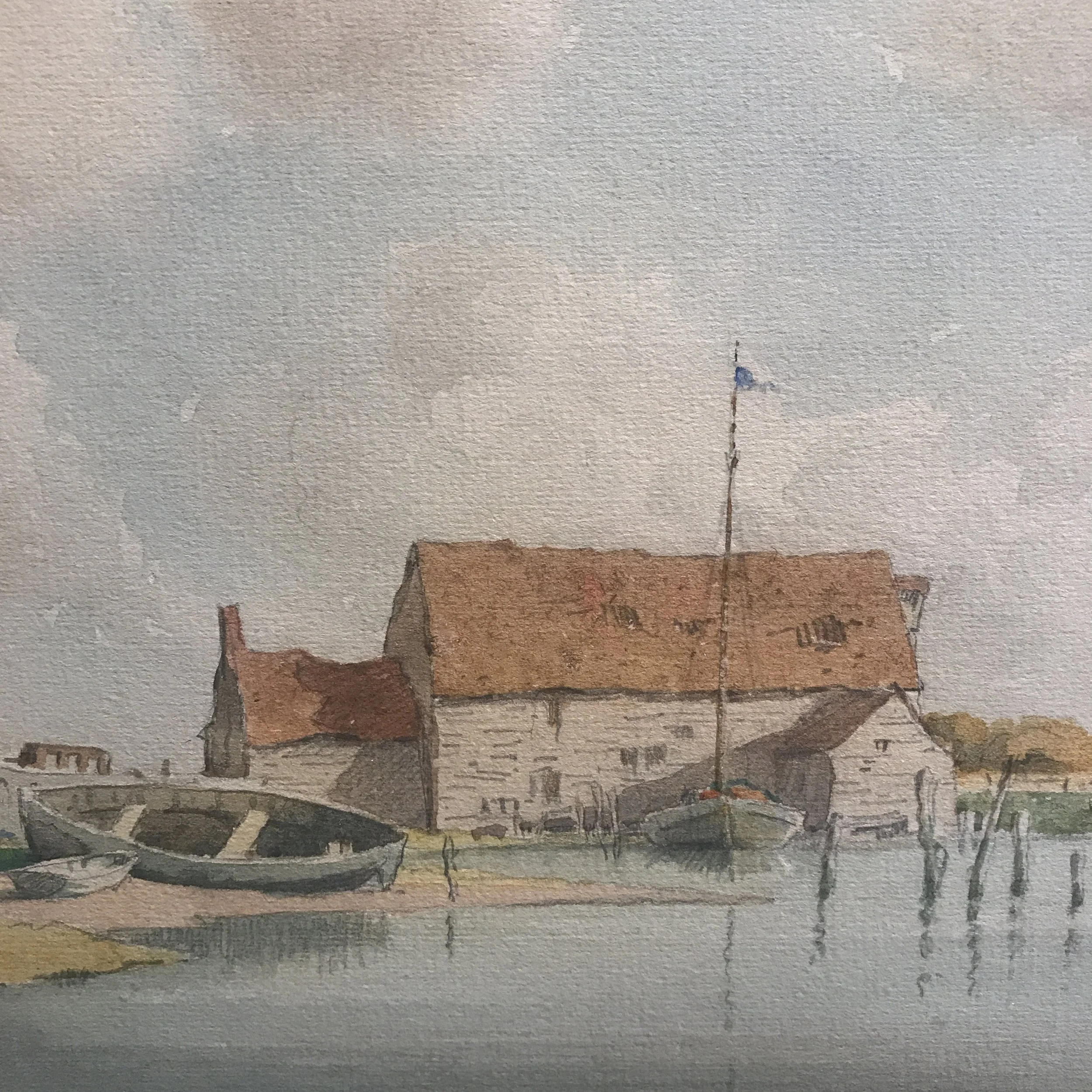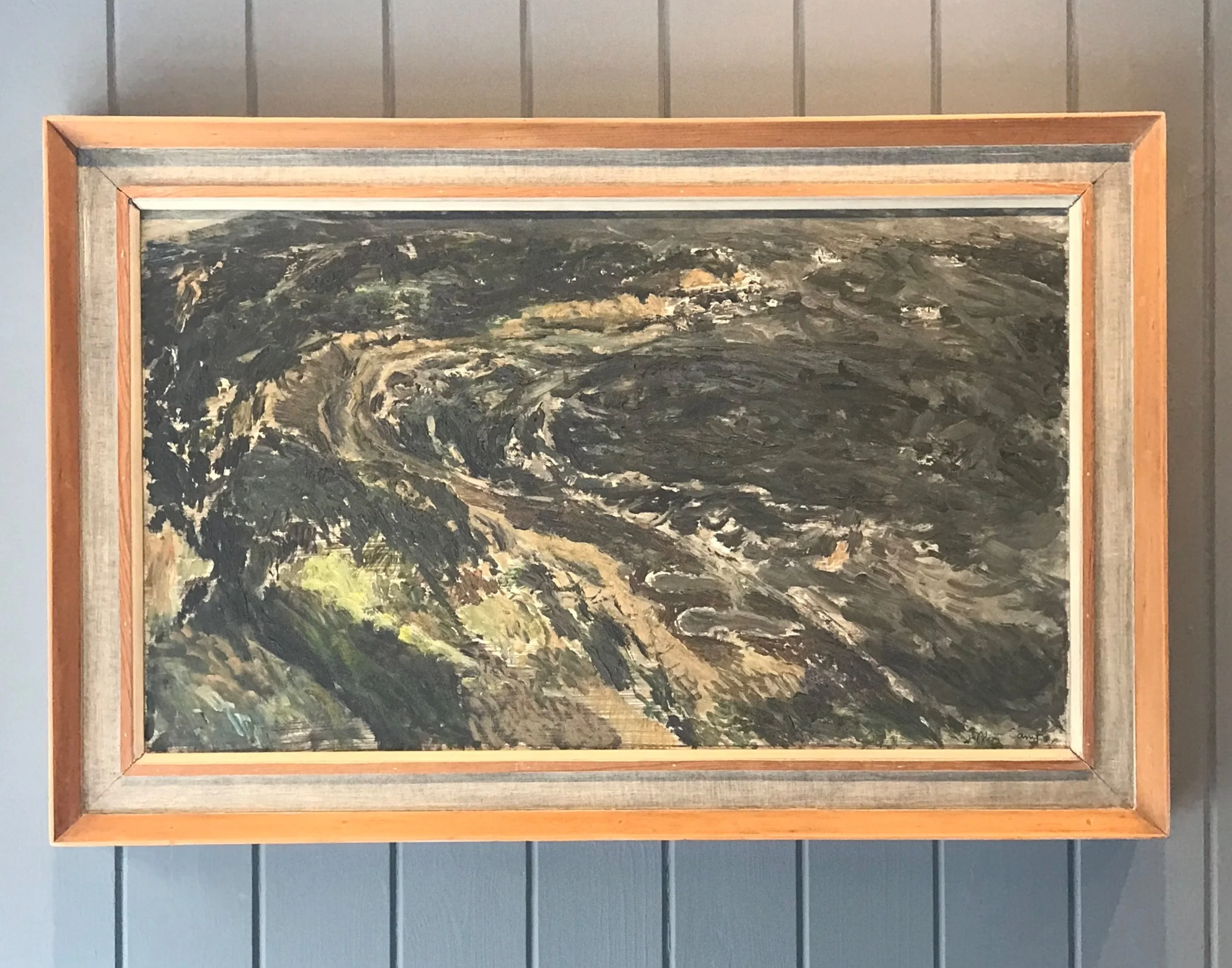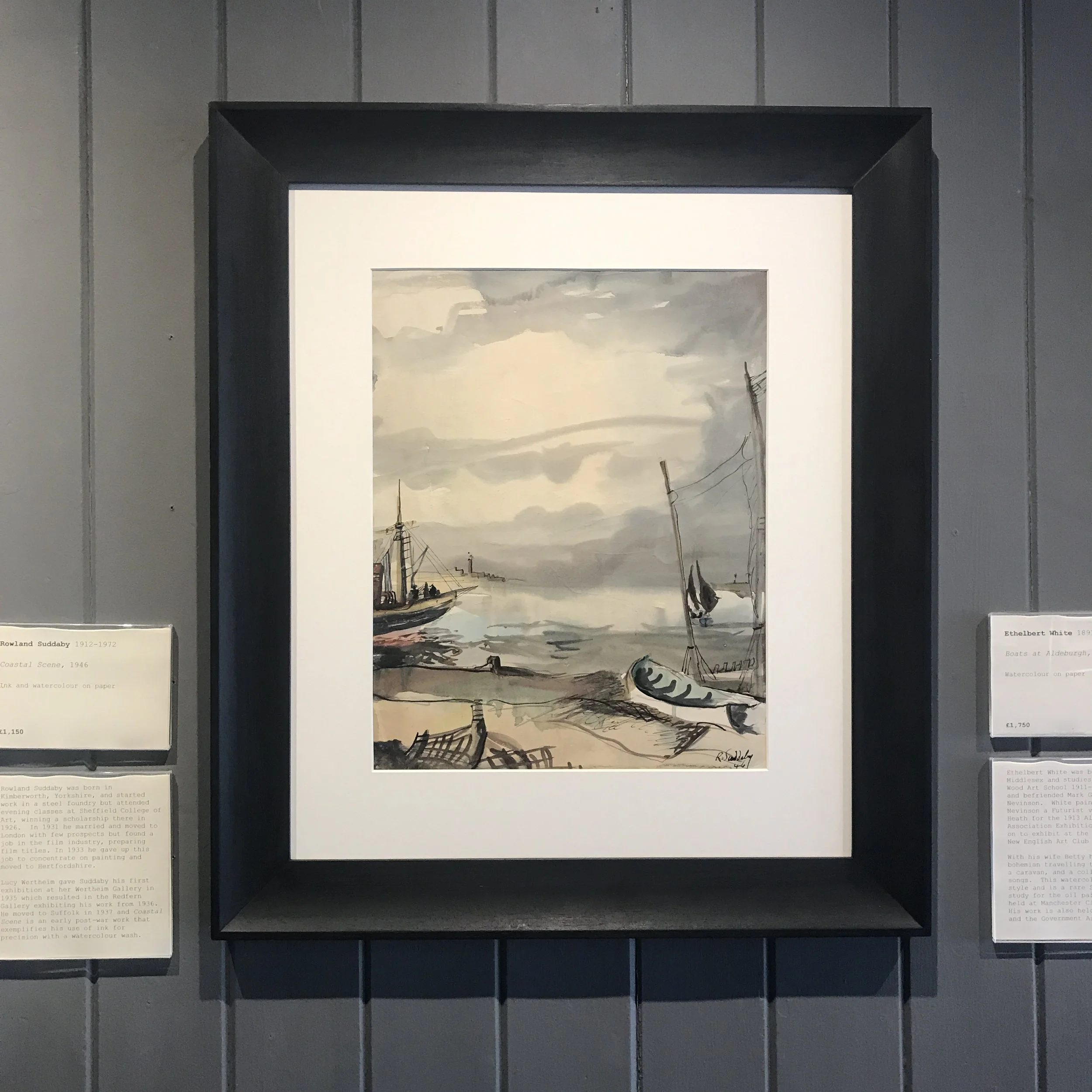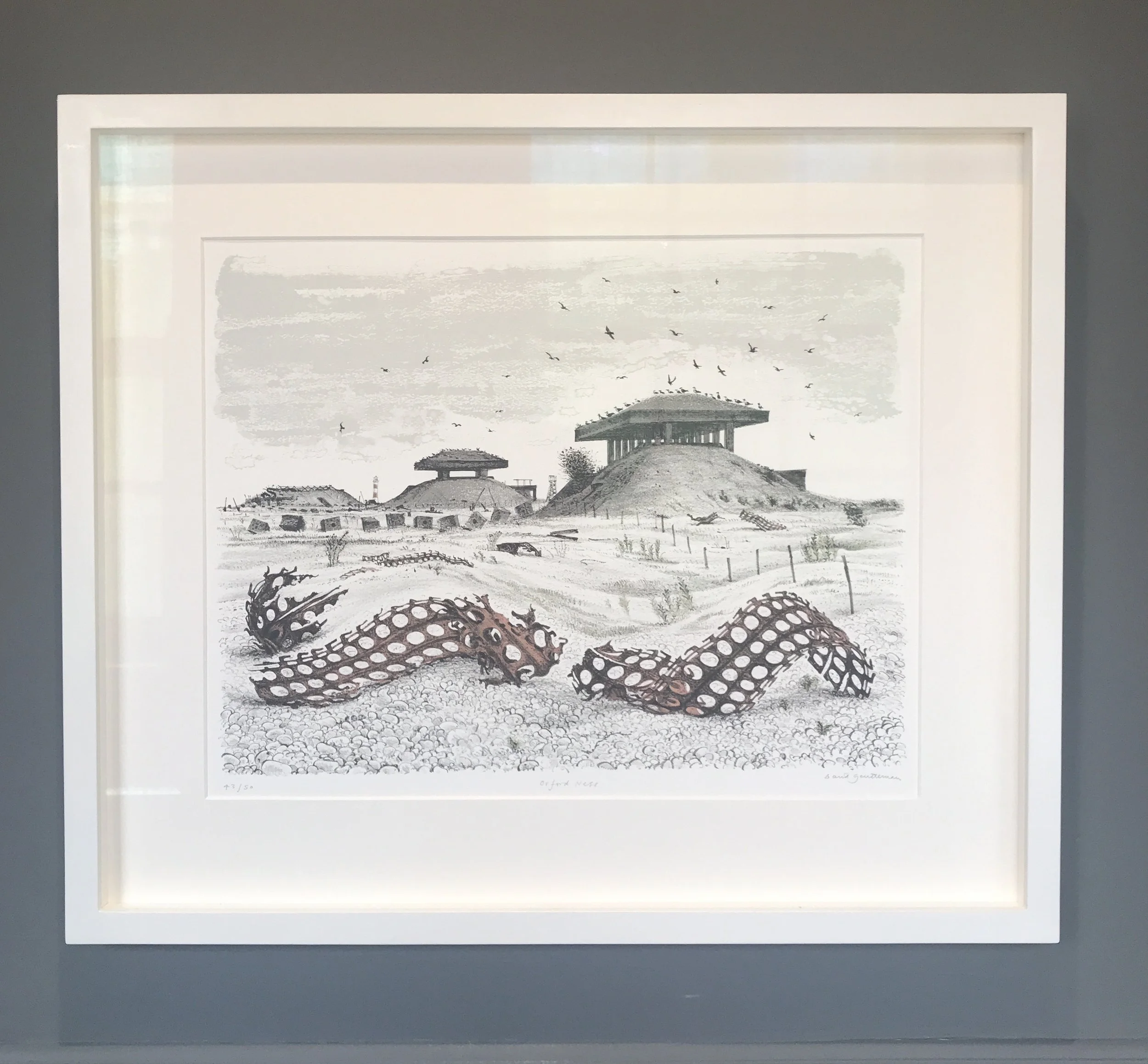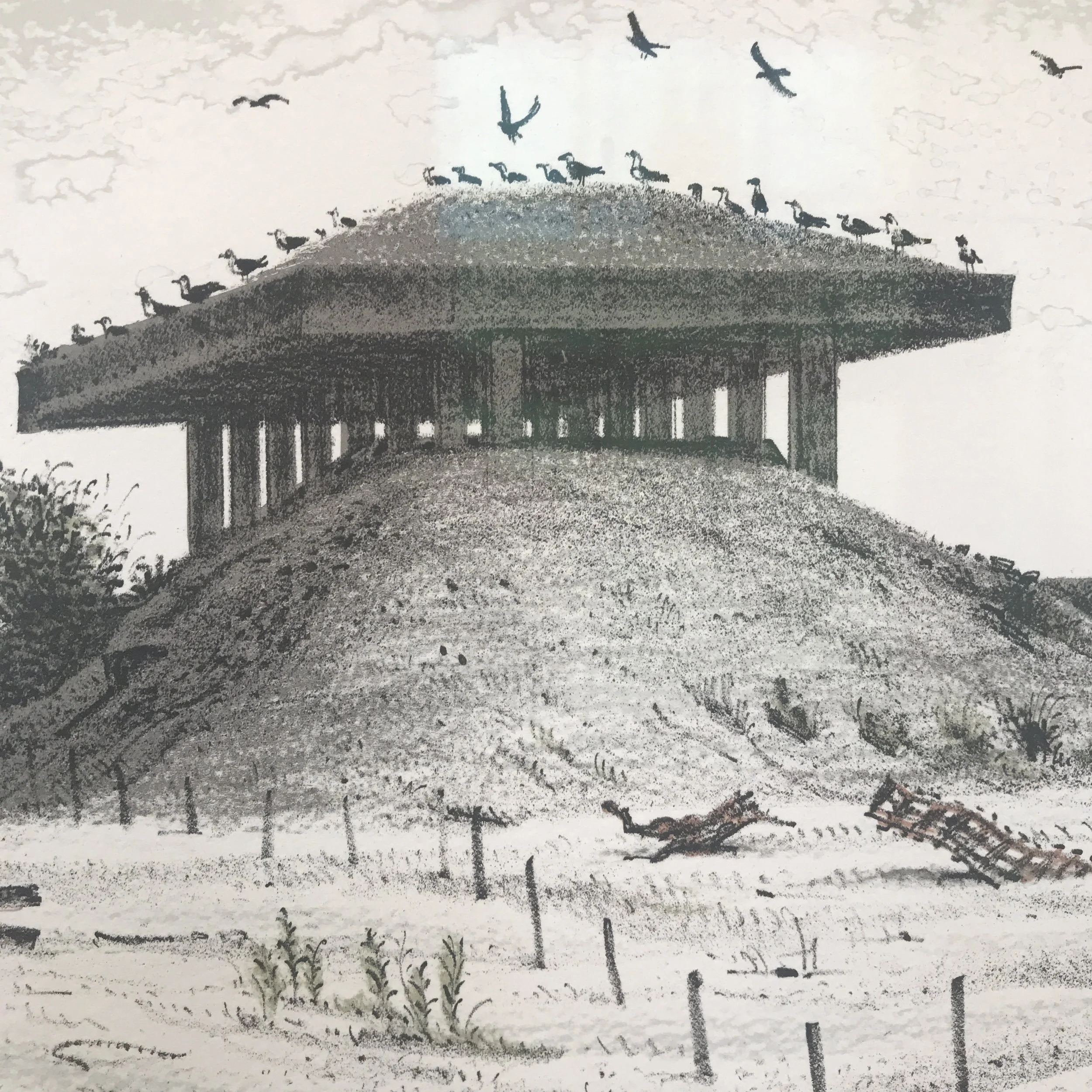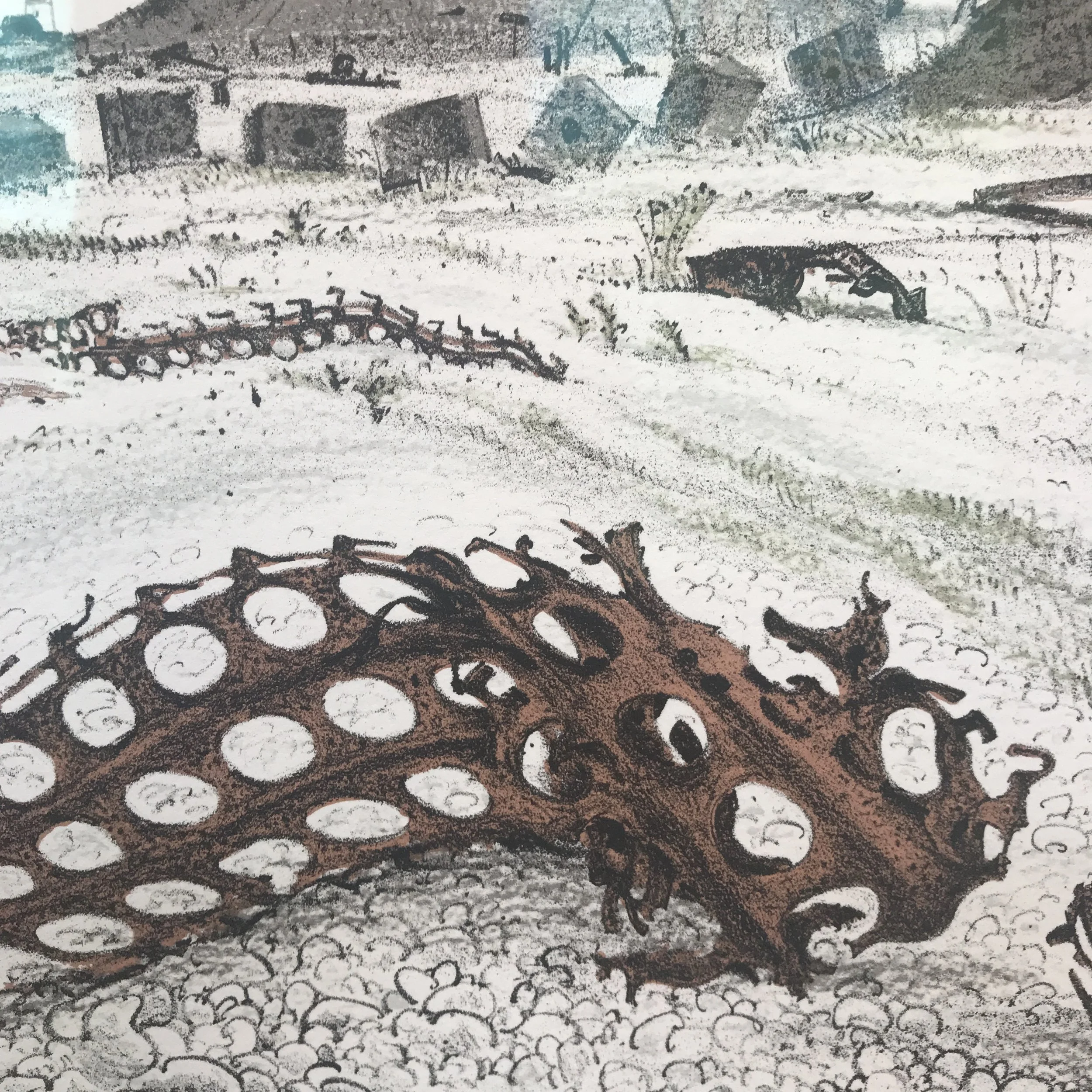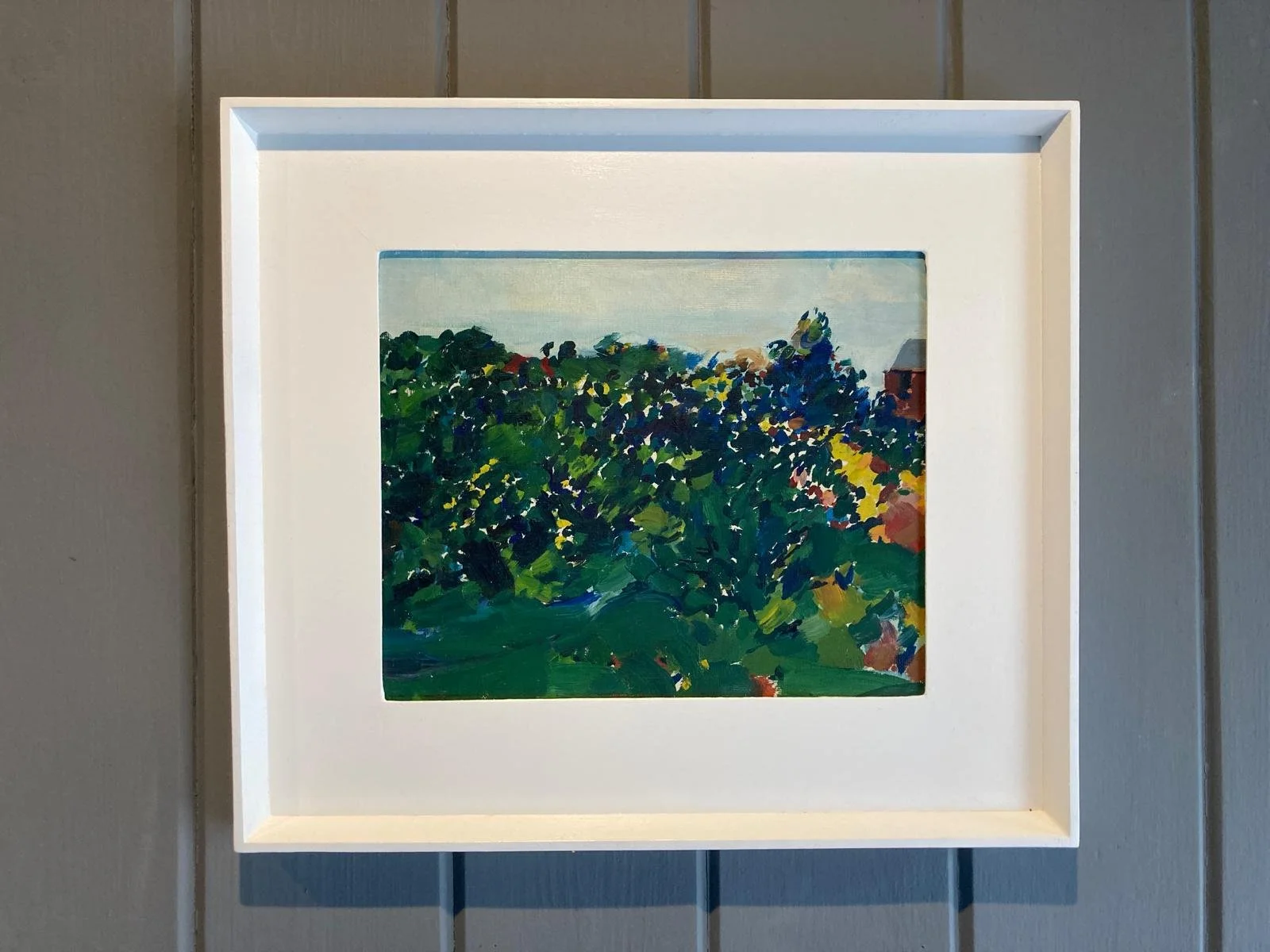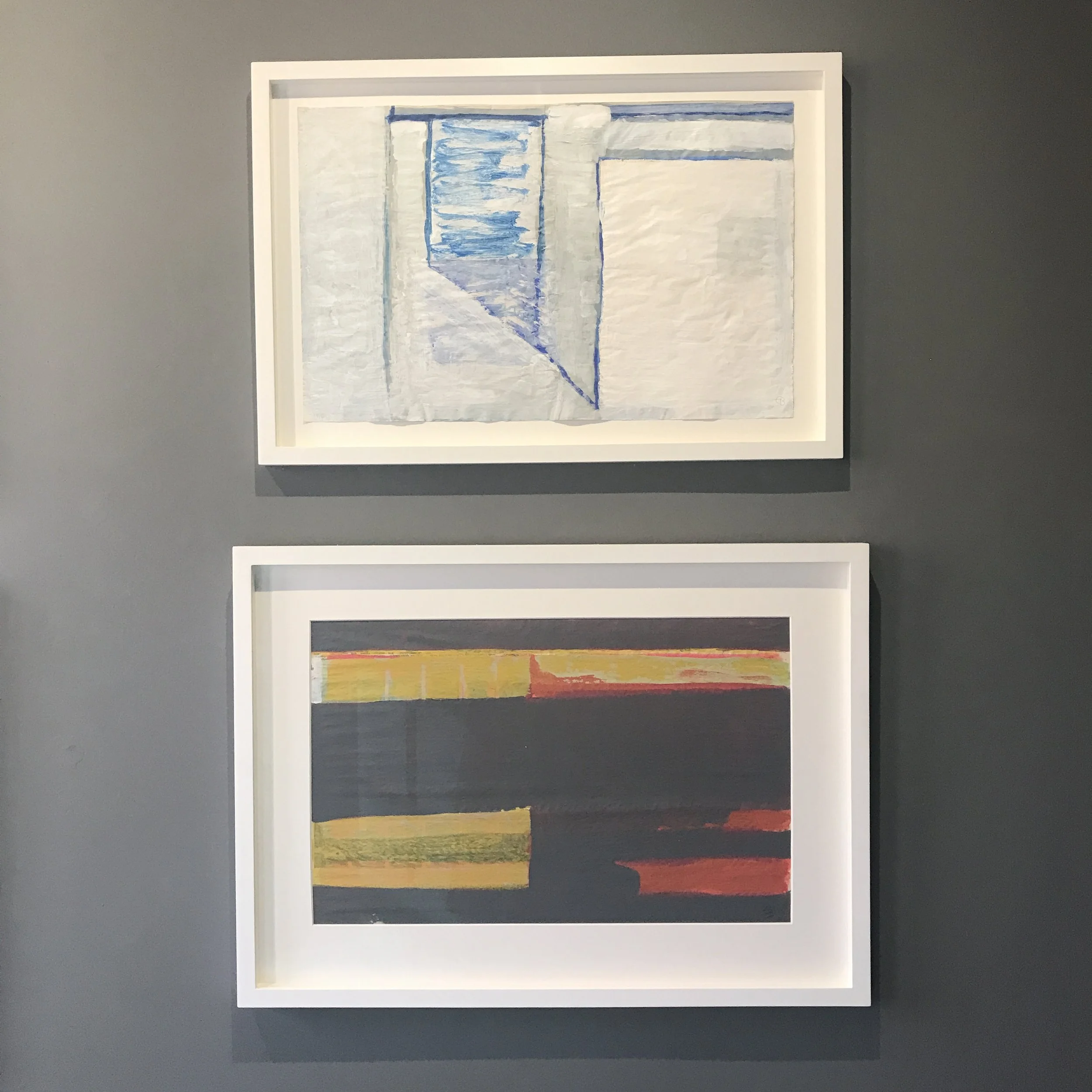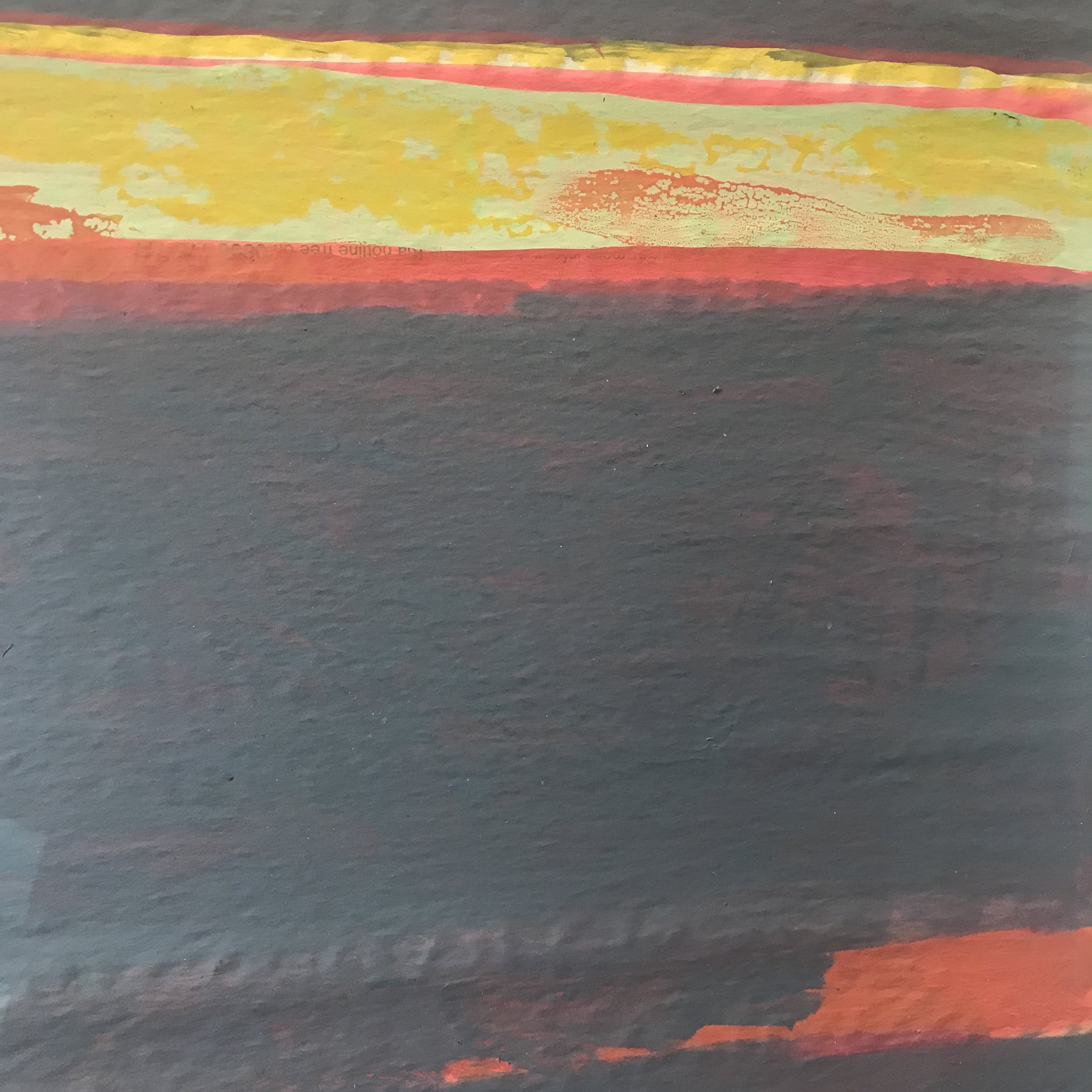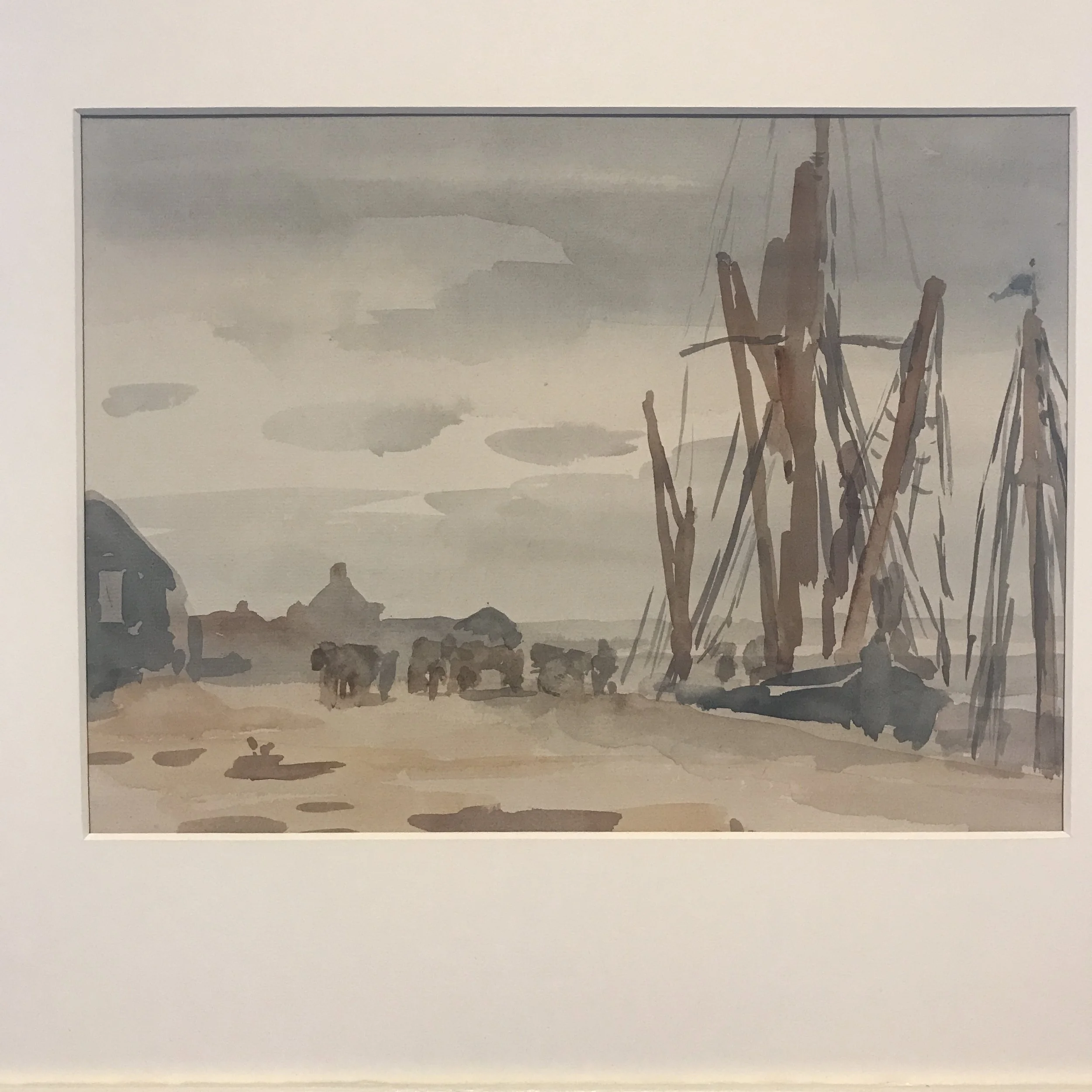Summer Coast
A show to celebrate Summer - this display, set out over two floors, includes paintings and prints that capture the working coast as well a place for relaxation.
Works by Christian Aldridge, Charles Bartlett, Frank Beanland, William Benner, Jeffrey Camp, Thomas Collier, Henry Collins, John Dodgson, David Gentleman, Liam Hanley, Martin Hardie, Anthony Levett-Prinsep, Cavendish Morton, John O’Connor, David Smith, Philip Wilson Steer, Rowland Suddaby, Philip Sutton, Valerie Thornton & Ethelbert White. Works range from 1878 until the present day.
If you would like a price list please do email and we can send one to you.
Enjoy the show!
Henry Collins (1910-1994) Seascape with Figure, 1957. Oil on canvas laid on board. H:57.5 X W:120cms. SOLD.
Henry Collins was born in Colchester and studied at Colchester School of Art and the Central School of Arts and Crafts. He met fellow artist Joyce Pallot at the Colchester Art School in 1932 and they married in 1938. They formed a dynamic partnership from 1948 designing murals and exhibitions, including the Sea & Ships Pavilion at the Festival of Britain and then later producing many murals in new shopping centres across the UK.
Seascape with Figure is a major work from 1957, exhibited at the Colchester Art Society. The image of a fisherman carrying a basket on the beach alongside beached boats is presented through broken passages of colour, lending the painting a modern aspect. The subject matter recalls the early 1950s work of Prunella Clough, in which she depicted the fishermen of Lowestoft.
This painting has been conserved so that it looks as fresh as the day it was painted and is presented in its original frame.
Below: Henry Collins (1910-1994) Boat Yard, 1960s. Screenprint on paper.H:53 x 72cms SOLD
Above:John Arthur Dodgson NEAC PLG (1890-1969) The Beach, c.1950s. Oil on canvas.H:93 x W:83cms.
Dodgson was born in India and studied at Oxford University before attending the Slade School of Art (1913-15). He exhibited at the New English Art Club and the London Group and lived at Chelsworth in Suffolk. He taught at Camberwell and Chelsea 1946-58 and had a retrospective at Beaux Arts Gallery in 1959. After his studio burnt down in 1964 he stated ‘I had been saying to myself for some time “shall have to have a bonfire one day soon!”
He saved only four paintings from the fire and this major canvas is one of only 40 still in existence. It was included in his Beaux Arts show, exhibited at the Royal Academy, South London Gallery (1971) and Fine Art Society (1995). His work is in the Tate Collection.
Above: Ethelbert White (1891-1972) Boats at Aldeburgh, 1933. Watercolour on paper.
Ethelbert White was born in Isleworth, Middlesex and studies at St John's Wood Art School 1911-12, where he met and befriended Mark Gertler and C.R.W. Nevinson. White painted together with Nevinson a Futurist view of Hampstead Heath for the 1913 Allied Artists Association Exhibition and White went on to exhibit at the London group and New English Art Club from 1916.
With his wife Betty he was noted bohemian travelling the countryside in a caravan, and a collector of folk songs. This watercolour is typical in style and is a rare Suffolk image, a study for the oil painting dated 1933 held at Manchester City Art Gallery. His work is also held by Kettle’s Yard and the Government Art Collection.
Above: Top - Martin Hardie RE (1875-1952) East Anglian Estuary, c.1930s. Watercolour on buff paper. H:41 x W:51cms Below:Martin Hardie RE (1875-1952) High Tide, St Osyth, Essex, 1947. Watercolour on paper. H:40 x W:52cms.
Martin Hardie was born in London, studied classics at Cambridge and gained employment at the Victoria and Albert Museum. Wanting to gain a working knowledge of printing he studied with Sir Frank Short at the Royal College of Art. He later became Keeper of Paintings, Engravings, Illustration and Design at the V&A.
He exhibited at the Royal Academy, the New English Art Club and the Royal Society of Painter/Etchers. East Anglian Estuary is a classic ‘big sky’ image painted on buff paper, which lends it a delicate tonality. High Tide, St Osyth, Essexdepicts the tide mill that was demolished in 1962. His work is held in Tate and the British Museum.
Above:David Thomas Smith RE (1920-1999) Seascape, 1969. Acrylic on board. H:24 x W:67cms. SOLD
David Smith was born in Lowestoft where he attended the Technical College before Lowestoft and Norwich Schools of Art. He was a visiting lecturer at Framlingham College, Suffolk from 1939-40 before serving with the RAF when he was commissioned to sketch the bombing raids over Germany.
After the war he studied at the Slade School of Fine Art, winning a Scholarship to the British School, Rome in 1949. He taught at Chelsea School of Art from 1965-79. He is most known for his British Antarctic Survey commissions and his images of the British coastline. This rare painting is typical of his expressive knifed technique that captures a coastal subject in a thoroughly modern style.
Above:Jeffery Camp RA (1923-2020) Grey Sea, Suffolk, 1959. Oil on board. H:57.5 x W:88.5cms.
Jeffery Camp was born in Oulton Broad, Suffolk and attended Lowestoft and Ipswich Schools of art in 1939-40 and then studied at Edinburgh College of Art from 1941-44 under William Gillies who had studied in 1920s Paris. He returned to Suffolk in 1944 and took its coastline as his inspiration. He taught at the Slade School of Art from 1963 where he met and married the artist Letitia Yhap. They left Suffolk in 1967 and moved to Hastings.
Grey Sea, Suffolk depicts the coastline near Pakefield and dates from 1959 when he held his first exhibition at Helen Lessore’s Beaux Arts Gallery. The delicate colours indicate his debt to European modernism. He has work in the Tate and Arts Council Collections.
Above: Anthony Levett-Prinsep (1908-1983) Aldeburgh Beach, 1948. Oil on board. H:51 x W:60.5cms.
Anthony Levett-Prinsep was born in Litchfield and following a time in the Royal Berkshire Regiment, initially intended to be an architect but studied sculpture under John Skeaping and at the Central School of Arts & Crafts from 1931-5. By 1939 he lived at Fir Tree House in Snape. He was influenced by Bonnard and Modigliani and his work exudes a directness and boldness in its expressionistic technique.
He showed a single oil in the 1948 Aldeburgh Festival entitled Aldeburgh Beach which was larger (27” x 31.5”) than this oil of a similar subject. The beached boat lies next to a toppled capstan within a vivid texture inspired by Chaim Soutine (1893-1943) that is suggestive of desolation and decay.
Above: Christian Aldridge (1976-)Allegory, 2023. Oil on linen. H:30.5 x W:41cms.
Christian Aldridge works from a studio in Darsham, Suffolk alongside his teaching of mixed media at East Coast College in Lowestoft. His recent work overlays undiluted coloured shapes on brown grounds and their titles refer to grammatical terms and words that reference this overlaying that hint at erasure or hidden aspects. In our window we have displayed Allegory alongside the Henry Collins’ Seascape with Figure dated 66 years earlier that contains similar coloured shapes to demonstrate the continued practice and universal language within East Anglian Art.
Above: Rowland Suddaby (1912-1972) Coastal Scene, 1946. Ink and watercolour on paper.H:67 x W:58cms.
Rowland Suddaby was born in Kimberworth, Yorkshire, and started work in a steel foundry but attended evening classes at Sheffield College of Art, winning a scholarship there in 1926. In 1931 he married and moved to London with few prospects but found a job in the film industry, preparing film titles. In 1933 he gave up this job to concentrate on painting and moved to Hertfordshire.
Lucy Wertheim gave Suddaby his first exhibition at her Wertheim Gallery in 1935 which resulted in the Redfern Gallery exhibiting his work from 1936. He moved to Suffolk in 1937 and Coastal Scene is an early post-war work that exemplifies his use of ink for precision with a watercolour wash.
David Gentleman RDI (1930-) Orford Ness, 2007. Lithograph on paper. Edition Number 43/50. H:55 x W:65cms. SOLD
David Gentleman was born in London growing up in Hertford and studied art and painting at the Royal College of Art under Edward Bawden and John Nash after National Service served in Cornwall, experience that provided the inspiration for his first major work 'Cornish Pilchard Boat’ a lithograph produced for the innovative Lyons Lithograph series in 1951. He has worked in watercolour, lithography and wood engraving, at scales ranging from platform-length murals for Charing Cross Underground Station in London to postage stamps and logos.
He moved to Suffolk following marriage to the daughter of the writer George Ewart-Evans and was commissioned by Aldeburgh Festival in 2007.
Above:Philip Sutton RA (1928-)Snape Common, Suffolk, 1957.Oil on board.H:31 x 35.5cms. SOLD
Philip Sutton was born in Poole, Dorset, but grew up inLeyton, east London. He left school at the age of 14, and worked in a drawing office before carrying out his National Service in the RAF. He studied at the Slade from 1949 and after winning a scholarship prize he travelled in Europe in 1953 before he began teaching at the Slade. He sold his first painting to Peter Pears, who with Benjamin Britten offered Sutton the use of Joy Cottage in Snape from 1955-8.
His work rapidly evolved during this time in Suffolk, moving from dark blocky landscapes to a looser technique and brighter palette. This powerful image belies its scale and it was exhibited in Australia in 1963.
Above:Thomas Collier RI 1840-1891 Walberswick Marshes, July 1878. Watercolour on paper. H:40 X W:49cms
Thomas Collier was born in Derbyshire and studied at Manchester School of Art before moving to north Wales to paint in the footsteps of the great watercolourist David Cox. He moved to London in 1870 and was elected a member of the Royal Institute of Painters in Watercolours the same year.
Whilst not prolific Collier was seen by fellow artists and critics as a master of watercolour following David Cox in capturing the ‘subject’ of atmosphere and light. He was described as ‘the finest of sky painters, especially of rain and cumulus clouds’. Collier was awarded the Legion d’Honneur in 1878 for his submission to an exhibition in Paris. He visited the Suffolk coast at Aldeburgh and Southwold in July 1878.
Above:Frank Beanland (1936-2019) Blue Grey Green Channels, 2004. H:47 x W:69cms. Grey, Yellow and Red, 1990s. Acrylic on newsprint. H:54 x 74.5cms.
After studying at the Slade School of Art from 1959-61 and winning a scholarship prize to Sweden, Frank Beanland moved to Cornwall in 1962-4. Here he was associated with the Porthleven Group of artists and adopted abstraction before teaching at Swansea College of Art and then moving to Suffolk in 1966.
Beanland’s early paintings applied with a palette knife gave way to his acclaimed spot paintings from 1965 which introduced his broad spectrum of colour. He later adopted a technique of using acrylic paints on newspaper print which provided a quick process on a low-cost material that allowed greater risk taking and fluidity in his work, which became more geometrical.
Above:Philip Wilson Steer OM NEAC (1860-1942) Unloading Barges, Maldon, Essex, c.1920s. Watercolour on paper.H:45 x 52.5cms.
Philip Wilson Steer was born in Birkenhead and after aborting a career in the Civil Service he studied at Gloucester School of Art and South Kensington School of Art. From 1882-4 he studied in Paris at Academie Julien and Ecole des Beaux-Arts, becoming a follower of the Impressionists. He first visited Walberswick in 1884 and stayed there every summer until 1887 developing his British Impressionist style, exploring light in his works through the use of broken colours.
He later specialised in watercolours which became looser in technique but retained his interest in light with exceptional tonal qualities. Unloading Barges, Maldon, Essex, is a strong example of this late work.





